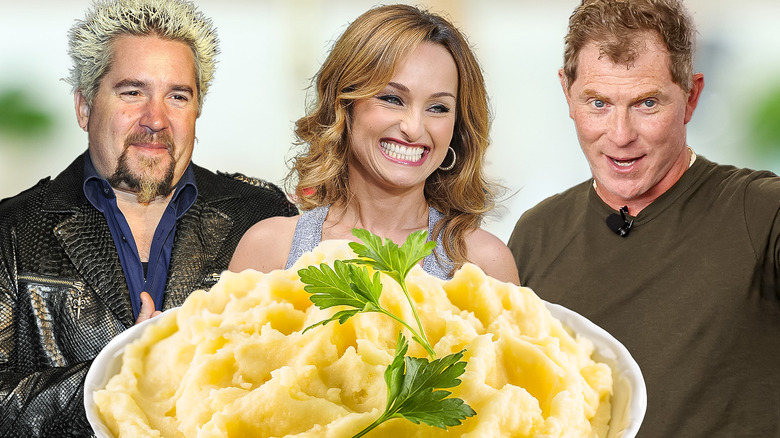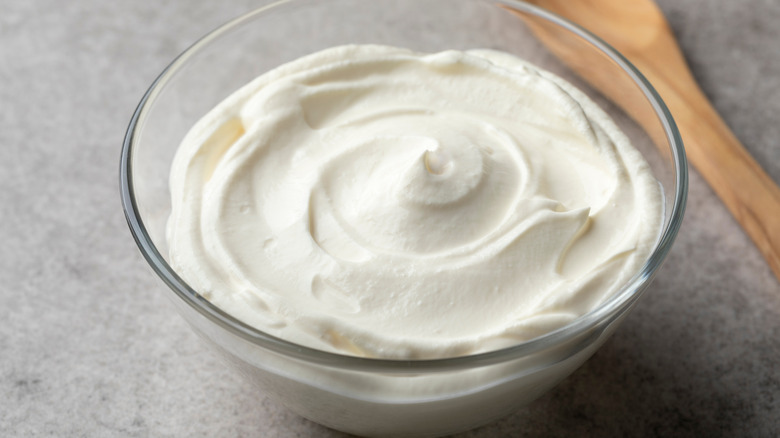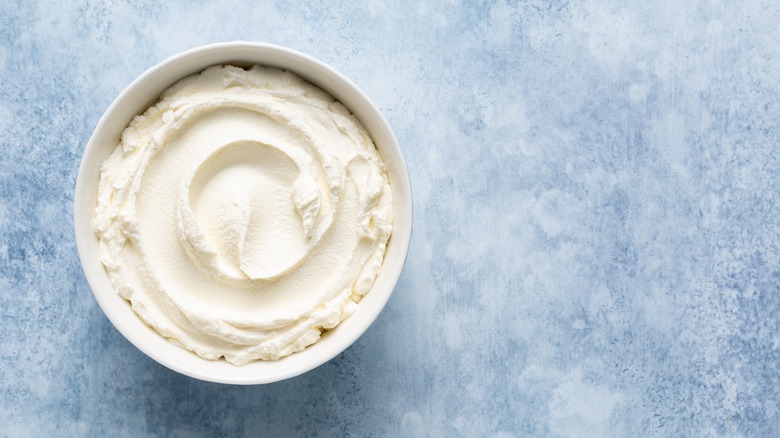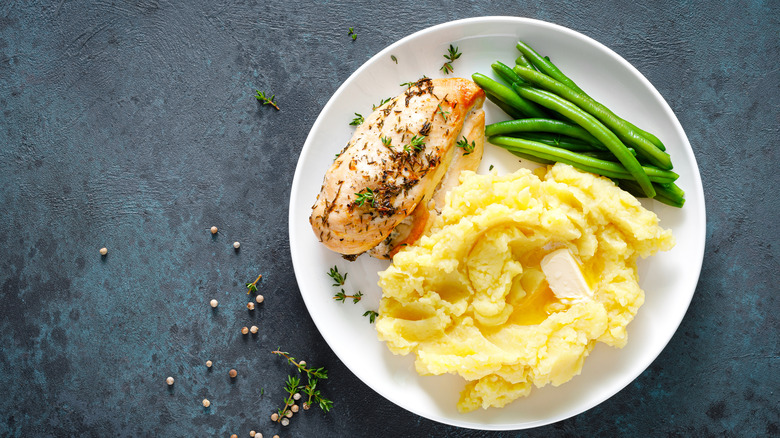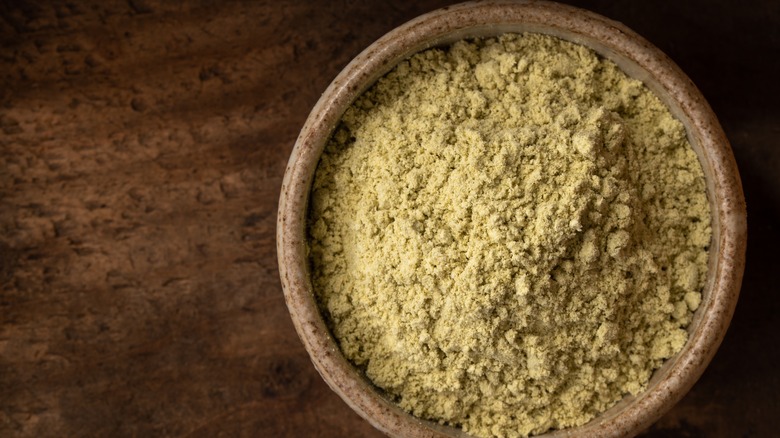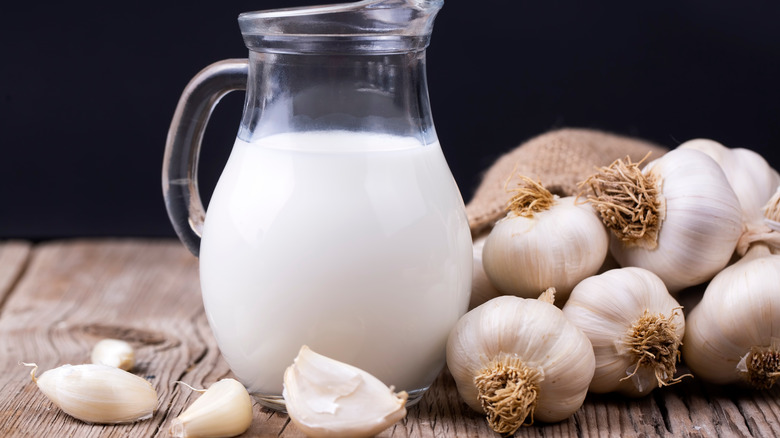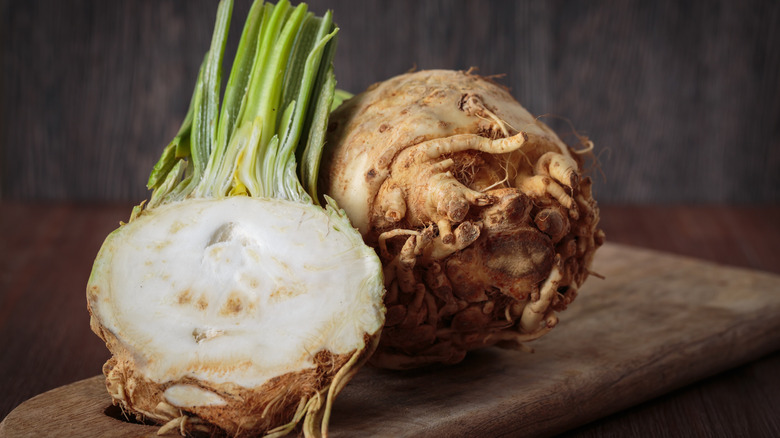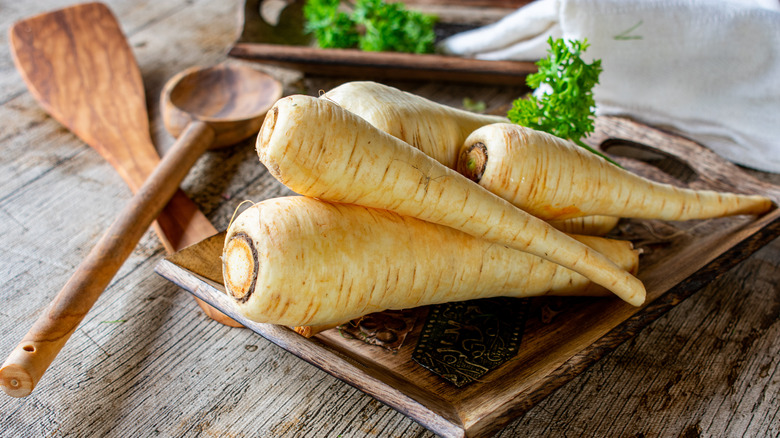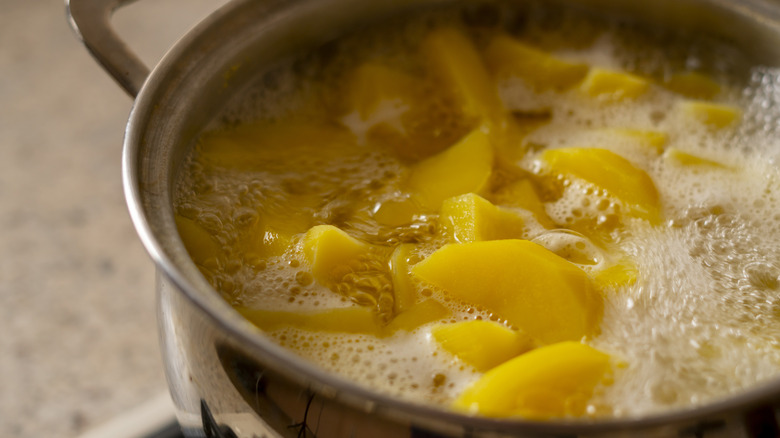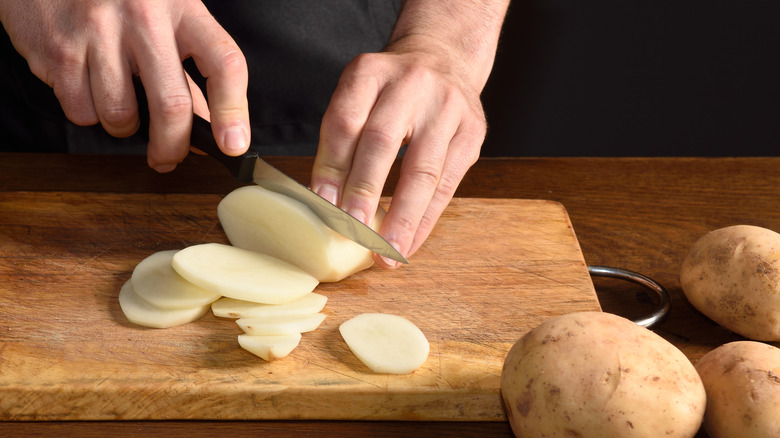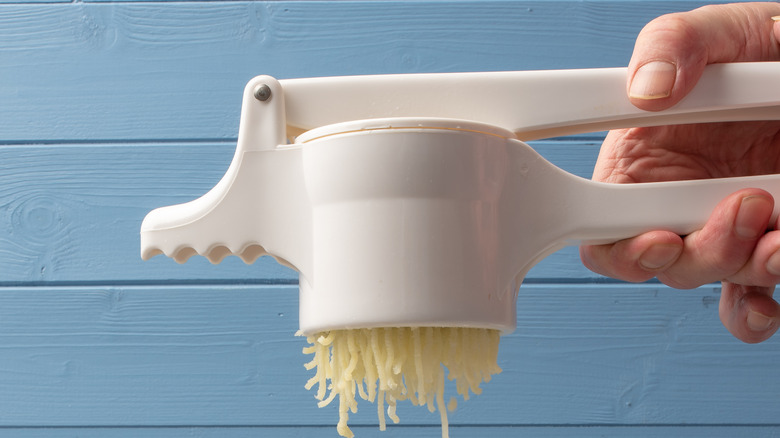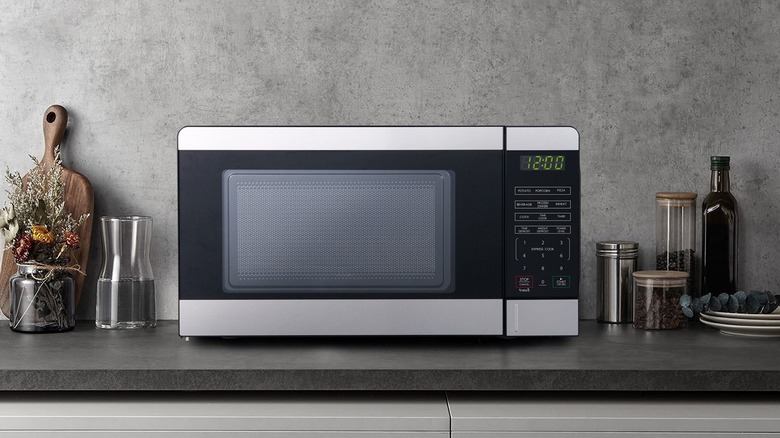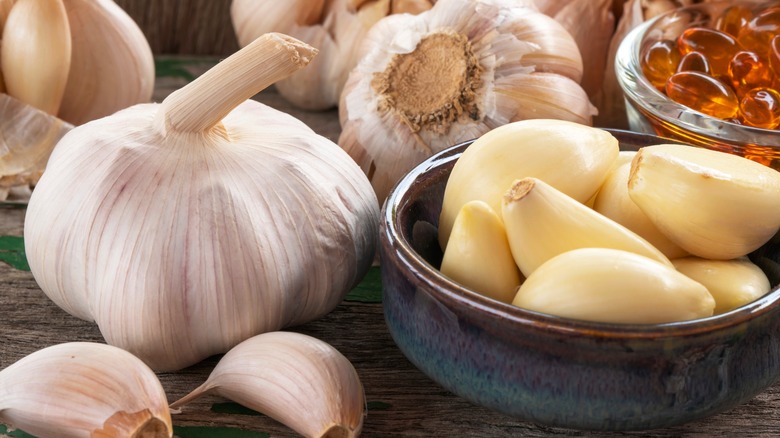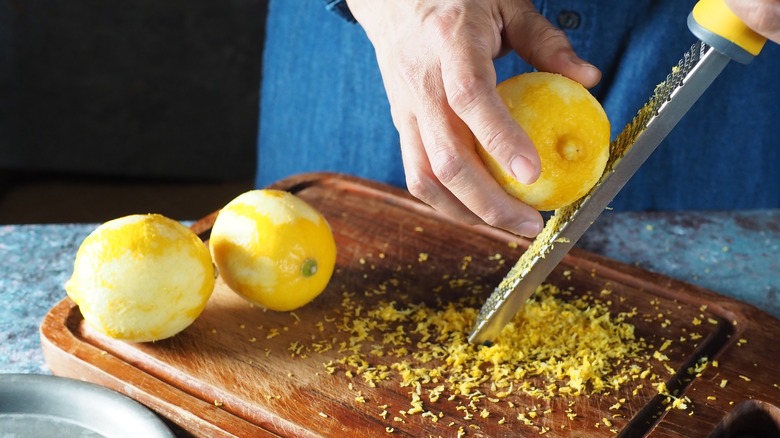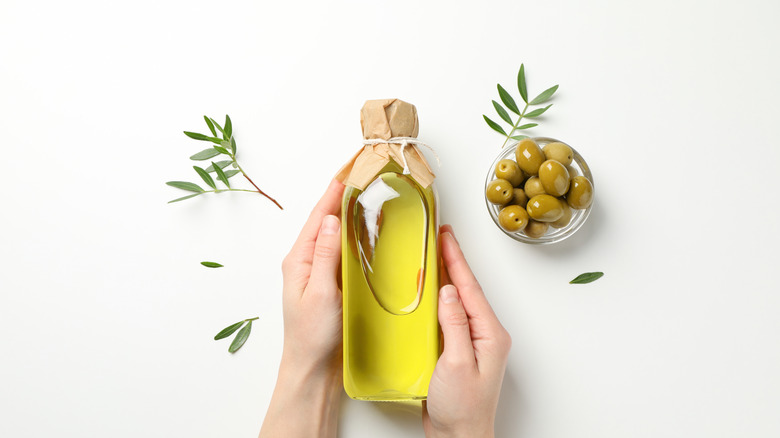16 Celebrity Chef Tips For Making The Best Mashed Potatoes
No Thanksgiving table would be complete without the side dish that triumphs over all others: mashed potatoes. This seemingly simple staple comprises a fundamental list of ingredients like potatoes, cream, and seasoning, but many questions accompany the recipe. For example, what kind of potatoes are best for mashed potatoes? How do you prevent the potatoes from gumming up during the mashing stage? And how do you elevate the flavors of mashed potatoes from boring to being the star of your next family dinner?
If there's a group of people that can help you make the best mashed potatoes, it's celebrity chefs. These folks have had several years under their belts crafting a litany of dishes –- especially ones geared toward home cooks. They've done the experimentation steps for what kinds of ingredients and techniques work well, and are often passionate about elevating simple dishes. Though we will note that our definition of "chef" is broad, but all of these folks do have great tips for cooking mashed potatoes. Here are some of the ways that they suggest improving your mashed potatoes.
Bobby Flay: Use crème fraîche for an unctuous texture
While you might associate celebrity chef Bobby Flay with the grill, the man also makes a mean dish of mashed potatoes. His secret ingredient for mashed potatoes results in silky smooth potatoes every time and a creamy flavor that is bound to impress all of your dinner guests. While Flay uses conventional butter and milk, he also adds a dollop of crème fraîche to his potatoes. His recipe uses a ½ cup of crème fraîche per 3 pounds of potatoes; Flay prefers russets or Yukon golds.
Crème fraîche is an excellent ingredient to add to mashed potatoes for several reasons. Unlike sour cream, this dairy product contains significantly more fat, fermentation agents, and bacterial cultures. For this reason, it has a texture more akin to yogurt than sour cream. The cultures and the lactic acid in the crème fraîche add a tangier flavor to the mashed potatoes than sour cream and can lower the pH of the potatoes, which in turn results in a thicker, creamier consistency.
Giada De Laurentiis: Keep things creamy with mascarpone
Giada De Laurentiis is a queen of entertaining and cooking, so it's no surprise that she has a cooking tip for almost anything. The ingredient De Laurentiis adds for perfect mashed potatoes is usually found in decadent desserts like tiramisu. Her mascarpone mashed potatoes are rich in texture and complemented with the flavors of other ingredients like chicken broth, Parmesan cheese, garlic — and butter.
De Laurentiis' recipe calls for 1 cup of mascarpone per 4 pounds of potatoes. She also judicially adds about 6 tablespoons of butter to her recipe (after all, we never said mashed potatoes were the most nutritionally dense). Mascarpone has more creaminess than cream cheese or crème fraîche, making it one of the most fat-dense options to add to your mashed potatoes. Full-fat mascarpone is the way to go for this recipe, but folks watching their fat intake can choose a lighter option, such as cream cheese, clotted cream, or crème fraîche.
Jöel Robuchon: Don't skimp on the butter
Butter and mashed potatoes are best friends — and always should be. But is there such a thing as adding too much butter to your mashed potatoes?
Chef Jöel Robuchon would probably argue against the theory. His purée de pomme recipe uses a massive amount of butter — close to a 2-to-1 ratio. This means that for every pound of potatoes in the recipe, Robuchon would add ½ pound of butter (two whole sticks). Although your arteries are likely clogging at the sound of this statistic, it's one of the keys to making the perfect mashed potatoes. Robuchon also had a very diligent technique in preparing his mashed potatoes. First, the chef would boil his potatoes with the skin on before cooling them and peeling them. Then, the chef would add the peeled potatoes to a food mill on the finest setting before finishing the spuds with ample butter, milk, and salt.
Guy Fieri: Get some heat with wasabi powder
The mayor of Flavortown, Guy Fieri, knows how to bring the heat — especially when it comes to mashed potatoes. One of the unexpected ingredients he uses in his mashed potato recipe is spicy wasabi powder. Not only does this match Fieri's passion for all things out-of-this-world spicy, but it provides an undercurrent of complexity that easily improves the flavor of the potatoes.
Like other chefs, Fieri starts his mashed potato recipe with the standard ingredients: potatoes, heavy cream, roasted garlic (a whole head), butter, salt, and pepper. But then, Fieri suggests making a wasabi paste with four teaspoons of wasabi powder and ½ teaspoon of water. He then lets the paste sit and bloom for about five minutes before adding it to the mashed potatoes with the other ingredients. The resulting side dish has numerous pops of flavor from the roasted garlic and horseradish in the powdered wasabi mix.
Ina Garten: Try something new with goat cheese
The Barefoot Contessa, Ina Garten, enjoys making more with less — a theme that is symbolic in her numerous cookbooks and television show. She deeply appreciates the simplicity of any potato dish but takes a particular interest in mashed potatoes. She uses goat cheese in her flavor-packed mashed potato recipe to help add creaminess and a bright zing of flavor. The celebrity chef uses Yukon gold potatoes, butter, sour cream, garlic, and half-and-half to make her mashed potatoes. Then, she adds herby garlic goat cheese, softened to room temperature, to the mashed potatoes.
Garten recommends adding softened goat cheese to the potatoes while everything is still warm; this will cause the flavors to meld together better. After incorporating the ingredients, she passes the mixture through a food mill to minimize any clumps. If you want to take your mashed potatoes to new cheesy heights, you can bake the tray in the oven with a layer of Parmesan cheese on top until crispy.
Alton Brown: Take things up a notch with garlic-infused cream
Our two favorite variations on mashed potatoes are cheesy potatoes and garlic mashed potatoes. Alton Brown's easy step for next-level mashed potatoes will have you adding a new recipe to your weekly meal rotation. He makes the mashed potatoes as usual but takes the garlic and the heavy cream aside. He then smashes the six garlic cloves before poaching them in heavy cream. Once the mixture is aromatic, he pours it into the potatoes and mashes the mixture together until it resembles the perfect mashed potato consistency.
Why not just add the garlic straight into the mashed potatoes? Poaching the allium in the cream helps mellow out the otherwise sharp bitterness. You'll also get a more robust garlic flavor throughout since you also infused the cream. The milk can also help aid in digestion since the milk fat curbs some of the acidity in the garlic.
Anne Burrell: Use celery root
Food television personality, cookbook author, and former instructor at the Institute of Culinary Education, Anne Burrell clearly loves food — and being creative with it. Besides the typical mashed potato ingredients, Burrell adds a secret ingredient to her mashed potatoes: celery root. This ingredient, which is otherwise known as celeriac or turnip-rooted celery, can be found in the produce section of most grocery stores. It is somewhat underutilized in American cuisines but is often found in German and Puerto Rican dishes.
Although the celery root shares a similar name to the crunchy green veggie we pair with buffalo wings, the two have very different textures. Celery root is much starchier and resembles the taste and consistency of other root vegetables like parsnips. Burrell utilizes the celery root by cutting off the hard exterior, cubing the inside, and boiling it with the potatoes. Like other celebrity chefs, Burrell finishes her dish with ample amounts of butter, heavy cream, and salt.
Alex Guarnaschelli: Try out some other veggies
Root vegetables provide a world of opportunity for upgrading your mashed potatoes, according to "Chopped" judge and executive chef at New York City's Butter, Alex Guarnaschelli. Guarnaschelli adds other veggies to mashed potatoes to help enhance the dish's nutritional qualities. Her favorite veggies to use in mashed potatoes (besides the potatoes themselves) include sliced turnips and sunchokes. Guarnaschelli notes that adding these ingredients helps stretch the dish a little — and can add a layer of complexity that the humble potato just can't provide.
Ina Garten is also a proponent of using other vegetables in mashed potatoes. Her parsnip mash is a foolproof potato alternative because this root vegetable contains much less starch than a standard potato. When you're mashing a regular potato, you'll often notice that the texture gets gluey and gelatinous rather than smooth and silky. Parsnips can't be overworked as quickly, meaning the texture stays smooth despite your prodding.
Tyler Florence: Boil the potatoes in milk
Everyone knows the first step to making mashed potatoes: cubing and boiling your spuds in water. But chef and television personality Tyler Florence has a new idea. Florence boils the spuds in milk to bring a luxe touch to his mashed potatoes. Although this method may seem unusual to the ordinary person (and us too, frankly), it can dramatically improve the consistency of your mashed potatoes.
Florence brings 2 cups each of heavy cream and milk to a boil with 8 cups of unpeeled, quartered Yukon gold potatoes. He adds a bay leaf, thyme, and smashed garlic to the pot for flavor. He then strains the mixture, saving the cream, and removes the seasonings. Then, Florence mashes the potatoes and folks the cream mixture back in. Lastly, he finishes the potatoes with a bit of olive oil, a couple tablespoons of butter, and grainy mustard.
Martha Stewart and Ree Drummond: Cream cheese makes for a better texture
It's hard not to love cheesy potatoes. But what about cream cheese potatoes?
Several celebrity chefs have suggested using cream cheese to incorporate a mild tang and depth to mashed potatoes. Martha Stewart (although we should note, this was originally her mother's, Mrs. Kostyra's, recipe) recommends cream cheese as a staple ingredient in mashed potatoes. She uses 8 ounces of cream cheese for every 3½ pounds of white or Yukon gold potatoes. She also packs in the unctuous ingredients with a stick of butter and warmed heavy cream and milk. Finally, Stewart adds all of the ingredients in a stand mixer with a paddle attachment, whipping a ton of air into the potatoes and making them super creamy.
The Pioneer Woman Ree Drummond also uses cream cheese in her mashed potato recipe. She uses the same amount of cream cheese as Martha for 5 pounds of potatoes. Drummond notes that these potatoes can be made one to two days in advance and baked for about 30 minutes until warmed through before serving.
Alton Brown: Cut the potatoes into triangles for a more even cook
Mashed potatoes are not just about what you can add to them — there's also a significant technical component that is often neglected. Luckily, Chef Alton Brown has us covered. Brown cuts his potatoes in triangles before boiling them for the "perfect range of doneness and starch-gelatinization," (via YouTube). Alton recommends using a utility or a chef's knife to cut the potatoes into pieces like a pizza, then boiling the slices to get the perfect Thanksgiving side dish. In his recipe, Brown notes that the cooking time on these potato wedges should be about 15 to 20 minutes. The potatoes will be done when they can be easily smashed with tongs.
Another relevant question for mashed potatoes is if the peel should be left on or removed. While Alton Brown goes the peel route, leaving the peel on will prevent too much water from infiltrating the potato. Maybe Alton Brown will just have to investigate this in one of his following videos.
Michael Symon: Use a ricer
Proper mashed potato technique also carries over into how you prepare your potatoes after they're done boiling. Chefs suggest many ideas for transitioning your cubed potatoes into the smooth, mushy consistency you need for mashed potatoes. Options include the food mill, stand mixer, hand masher, and others.
Michael Symon prefers to use a ricer for perfect mashed potatoes. He strains the potatoes before adding them to the pot and pulling out his handy kitchen tool. Next, he runs the potatoes through the ricer for super fluffy mashed potatoes before seasoning them with ample amounts of butter. Rather than using milk, Symon sticks to a potato-to-butter ratio of 2-to-1. He then finishes his recipe with salt, pepper, and a bit of nutmeg. Although the ricer might seem tedious, Symon notes it reigns supreme above all other mashing methodologies. In a tweet, he said that mixers tend to "make [mashed potatoes] pasty."
David Chang: Stick to your microwave
We're always looking for ways to simplify our favorite dishes. Michelin-Star chef and owner of the Momofuku restaurant group David Chang uses a simple kitchen appliance to help make great mashed potatoes. Chang's technique for microwaved mashed potatoes will make you re-think how easy and achievable this side dish can be.
Chang begins his technique by peeling and chopping potatoes into medium-sized chunks before seasoning them with Momofuku savory salt. He then transfers the potatoes into a microwave-safe container with a lid and cooks the potatoes for eight minutes. "There's no way you're going to make a faster mashed potato," he shares on his Instagram video. After the cooking time is up, Chang adds a few tablespoons of butter and a splash of milk. Lastly, he mashes the potatoes with a hand-held potato masher, "It's some of the best mashed potatoes you'll ever make, I promise you on that one. Really simple."
Julia Child: Go wild with the garlic
If you're making mashed potatoes, you can comfortably live by the mantra "more is better." Unless you're just making a single serving of mashed potatoes for yourself, then maybe don't use 8 pounds of potatoes.
Julia Child is one chef that never let the power of flavor stop her. Her mashed potatoes are made with an absurd amount of garlic — we're talking 30 cloves. Her recipe was published in her 1961 cookbook entitled, "Mastering the Art of French Cooking: Volume 1." Child starts by blanching the unpeeled garlic cloves in hot water before peeling and cooking the cloves over medium heat with a few tablespoons of butter. She then transforms the mixture into a béchamel sauce by adding flour and milk and puréeing with a blender. Once the 2½ pounds of potatoes are finished boiling, Child passes the potatoes through a ricer before stirring in more butter, cream, the béchamel sauce, and seasoning.
Ina Garten: Add a refreshing twist with lemon zest
It's easy to drown in a batch of mashed potatoes. The dish can be so heavy and starchy that it feels like you're constantly gasping for air in between bites. But celebrity chef Ina Garten has a way of helping make mashed potatoes lighter and reminiscent of summertime. The refreshing ingredient Garten adds to puréed potatoes is lemon zest — which you likely already have access to in your kitchen.
The entertaining and cooking guru notes that adding lemon zest to puréed potatoes (which we should mention are just mashed potatoes with a fancier name) can help bring some brightness to your spuds. Garten uses a full tablespoon of zest per 2½ pounds of potatoes. She only adds the zest to the potatoes after they have been passed through a food mill and mixed with butter and seasoning. Unlike other mashed potato ingredients, zest should only be added right before serving because it tends to get bitter with time.
Stanley Tucci: Introduce fat with olive oil and egg yolks
You've probably deduced that the key to a good mashed potato is all in the fat. The most common additions, butter, cheese, cream, and milk, provide a familiar flavor and help the taste roll off your tongue. However, Stanley Tucci uses more unique fats in his mashed potatoes. His recipe, which was inspired by the culinary prowess of his wife, Felicity Blunt, uses olive oil and egg yolks for creaminess. Since olive oil can get especially, well, oily, it is important to use it as a butter substitute in the recipe. Therefore, a ratio of 8 tablespoons of butter (one stick) per 6 tablespoons of oil is appropriate.
Tucci adds the olive oil to the potatoes during the mashing step. Once that fat is well-mixed with the potatoes, he adds some butter and the raw egg yolks for creaminess. You won't have to worry about eating raw eggs, though, since the yolks will cook when mixed with the hot potatoes.
Static Media owns and operates Tasting Table and Mashed.
